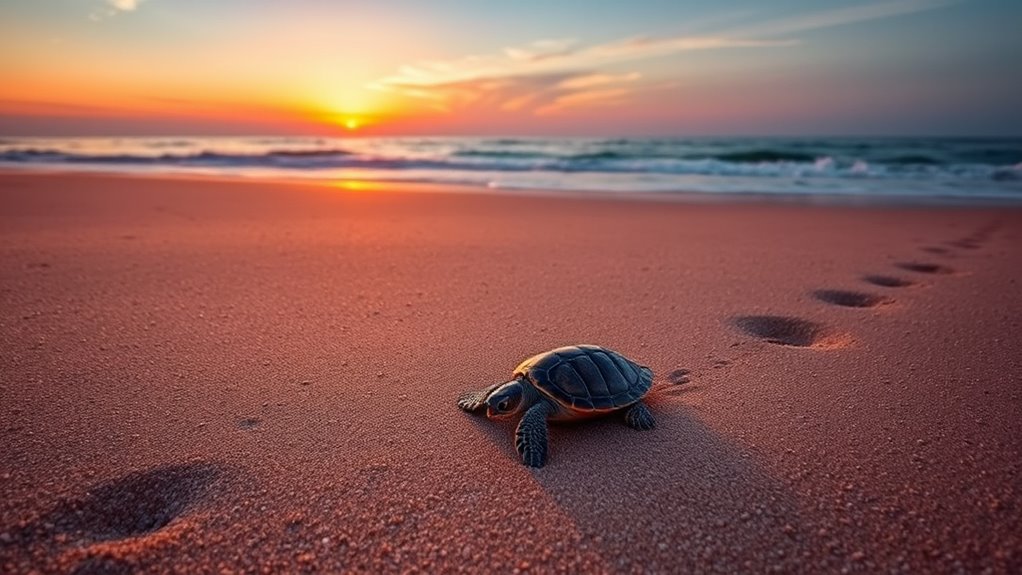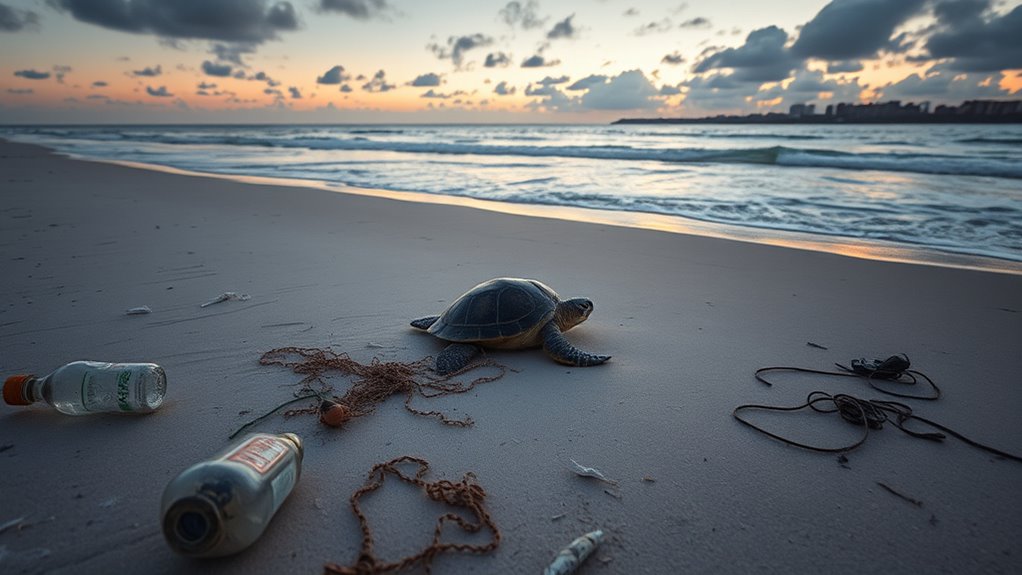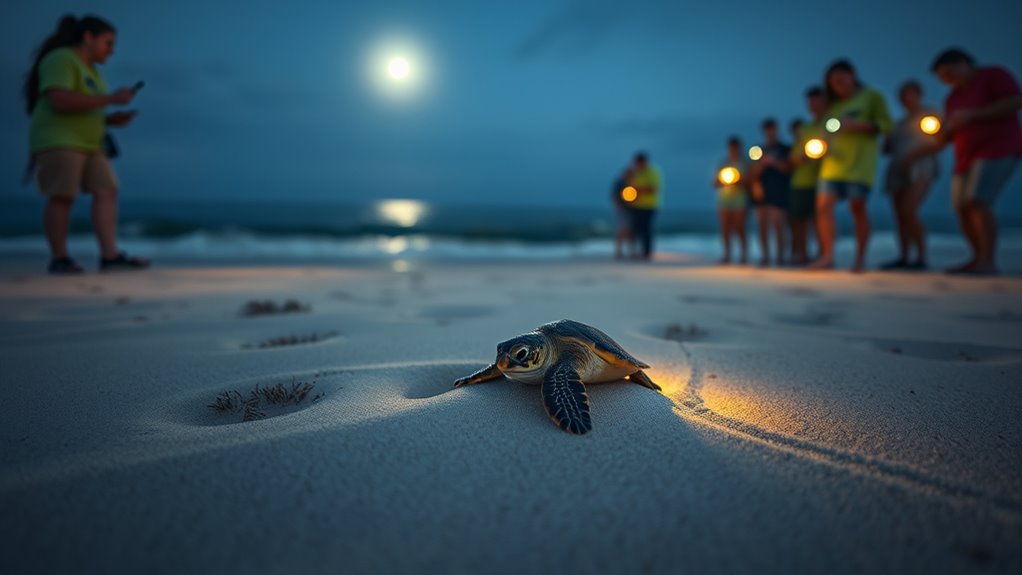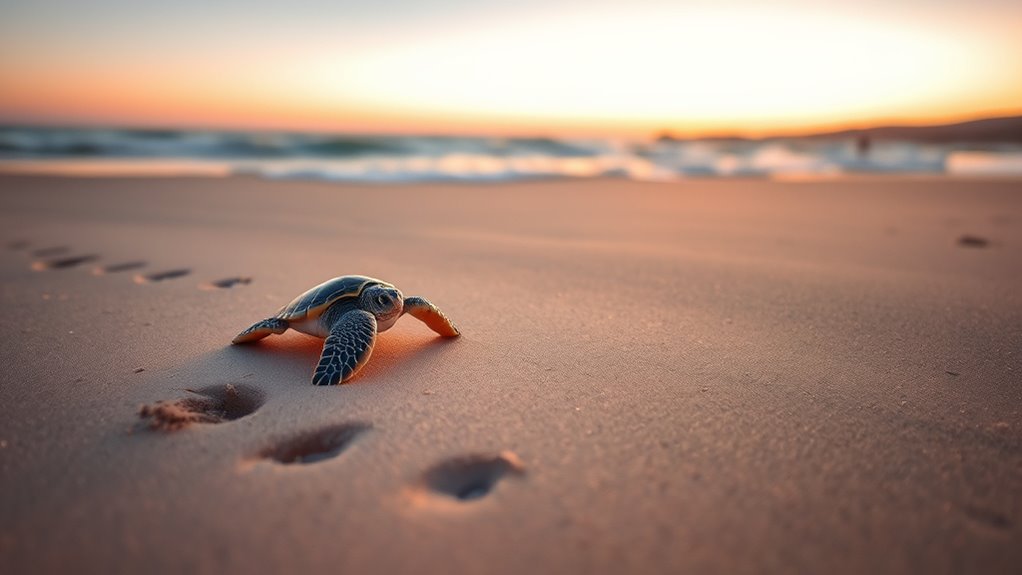Sea turtles find their way home by instinctively using Earth's magnetic field as a compass. After hatching, they head toward the ocean, guided by the moon's reflection and wave movements. As they grow, they imprint on their natal beach's unique magnetic signature, allowing them to return to the same shores decades later. This navigation process is fascinating and complex. To understand more about how they cope with environmental threats and what's being done for their protection, keep exploring the topic.
Key Takeaways
- Sea turtles rely on the Earth's magnetic field as an internal compass for navigation during long-distance migrations.
- Hatchlings imprint on the unique magnetic signature of their natal beach, which aids in future navigation.
- Turtles use visual cues, such as the moon's reflection on water, to orient themselves towards the ocean.
- Motion sensitivity allows hatchlings to respond to wave movements, guiding them to the sea.
- Changes in the magnetic field can influence nesting site choices, affecting turtles' ability to return home.
The Journey Begins: Hatchlings and Their First Cues

As soon as they hatch, sea turtle hatchlings commence on an essential journey, instinctively seeking the ocean's embrace. They rely on the moon's reflection on the water as their first visual cue, guiding them toward the waves.
As they swim, their motion sensitivity helps them respond to the wave movements, ensuring they stay on course. During this critical time, hatchlings also begin to detect the inclination angle and strength of Earth's magnetic field, which forms a mental map for future navigation.
This early experience becomes crucial as they imprint on the magnetic signature of their natal beach. Later in life, adult sea turtles depend on this imprinted information to return to the same beach for nesting, completing their life cycle.
The Role of Earth's Magnetic Field in Navigation

While traversing the vast oceans, sea turtles rely heavily on the Earth's magnetic field as their internal compass. This magnetic field helps them navigate thousands of miles back to their natal nesting sites.
Adult turtles can detect variations in the magnetic field, such as inclination angles and magnetic strength, which guide them along coastlines. Research indicates a strong link between turtle nesting patterns and shifts in the magnetic field, suggesting that turtles adapt their nesting behavior accordingly.
Geomagnetic Imprinting: How Turtles Remember Their Birthplaces

When sea turtles hatch, they imprint on the unique magnetic signature of their natal beach.
This remarkable ability helps them navigate back to the exact spot to lay their eggs later in life.
Understanding how they recognize these magnetic cues is key to appreciating their incredible journey home.
Magnetic Signature Recognition
Newly hatched sea turtles possess a remarkable ability to imprint on the unique magnetic signature of their natal beach. This process involves recognizing the inclination angle and strength of the Earth's magnetic field, allowing them to create a mental map. As adults, they navigate thousands of miles back to their nesting grounds using this internal compass, returning within a few hundred yards of their birthplace. Changes in the Earth's magnetic field can even influence where they choose to nest.
| Aspect | Description |
|---|---|
| Magnetic Signature | Unique to each natal beach |
| Earth's Magnetic Field | Guides turtles based on inclination |
| Imprinting | Mental map creation during hatching |
| Navigation | Long-distance travel using magnetic cues |
| Coastal Habitats | Areas where nesting density increases |
Natal Beach Fidelity
After imprinting on their natal beach's magnetic signature, sea turtles develop an impressive ability known as natal beach fidelity. This means that as an adult, you'll likely return to lay eggs within a few hundred yards of where you hatched.
Sea turtles use the unique magnetic signatures along coastlines as a mental map, allowing them to navigate thousands of miles of ocean. During your first journey to the ocean, you imprint on the inclination angle and strength of the Earth's magnetic field, creating a reliable internal compass.
Changes in the Earth's magnetic field can influence where nests are distributed, so you'll be more likely to nest densely in areas with similar magnetic signatures, ensuring future generations find their way home.
Nesting Behavior: Returning to Familiar Shores

As female sea turtles journey thousands of miles across the ocean, they exhibit an incredible ability to return to the exact beach where they hatched to lay their eggs. This remarkable nesting behavior is guided by their imprinting on the unique magnetic signature of their natal beach. Their return is essential for successful nesting, ensuring hatchling survival.
Here's a glimpse of factors influencing their nesting choices:
| Factor | Description |
|---|---|
| Sand Quality | Ideal texture for egg incubation |
| Temperature | ideal warmth for hatchlings |
| Predation Risks | Minimal threats from predators |
| Human Disturbance | Low interference from coastal activities |
The Importance of Coastal Habitats for Reproduction

Coastal habitats are essential for the reproduction of sea turtles, providing critical nesting grounds where females return to lay their eggs. This behavior, called natal homing, guarantees that nesting turtles choose familiar coastlines, which offer ideal environmental conditions.
Soft sand and the right temperatures are crucial for egg survival, as is a low presence of predators. When turtles select their nesting sites, they look for accessible beaches that create a safe habitat for their offspring. These unique coastal areas greatly influence hatchling development, making them integral to the species' lifecycle.
Unfortunately, human activities like development and pollution threaten these habitats, jeopardizing nesting success and the overall sustainability of sea turtle populations. Protecting these environments is important for their future.
Environmental Threats to Nesting Sites

Nesting sites for sea turtles face numerous environmental threats that jeopardize their survival. Coastal development, like urbanization and beach resorts, destroys habitats and limits access for nesting females.
Pollution from plastic debris and chemical runoff harms nesting beaches, negatively affecting both adult turtles and hatchlings. Climate change exacerbates these issues, causing rising sea levels and increased sand temperatures that alter nesting conditions and reduce hatchling survival rates.
Additionally, incidental capture in fishing gear and the presence of predators, drawn in by human activity, further threaten successful nesting. With thousands of sea turtle nests lost annually due to these human activities, it's essential to implement effective conservation strategies to safeguard these indispensable habitats for future generations.
Conservation Efforts to Protect Sea Turtles

You can play an essential role in protecting sea turtles through local beach cleanup initiatives and supporting habitat protection legislation.
By participating in these efforts, you help create safer nesting environments for these incredible creatures.
Every action counts in the fight against pollution and coastal development, ensuring future generations of sea turtles can find their way home.
Beach Cleanup Initiatives
Thousands of sea turtles return to the shores each year to nest, but their survival is increasingly threatened by pollution and habitat degradation.
Beach cleanup initiatives play an essential role in reducing these threats, ensuring safe environments for turtles to lay their eggs. Local communities and NGOs work together, and you can contribute by participating in organized cleanups.
Here are three ways you can help:
- Join local cleanup events to remove litter from nesting beaches.
- Support programs like the Campeche Turtle Project, which restore natural nesting behaviors.
- Advocate for turtle-friendly lighting to prevent hatchling disorientation.
Your involvement makes a difference in conserving sea turtle habitats and reducing pollution, helping these incredible creatures thrive for generations to come.
Habitat Protection Legislation
Protecting the habitats where sea turtles nest is essential for their survival. Habitat protection legislation plays a key role in safeguarding nesting beaches from coastal development and human disturbances.
By establishing laws that limit pollution and harmful activities, you help guarantee these critical areas remain viable for turtle reproduction. Conservation initiatives, like creating protected marine areas, bolster these efforts by offering safe spaces for nesting and foraging.
Additionally, advocating for strict regulations on artificial lighting is crucial; it prevents hatchlings from becoming disoriented, allowing them to find their way to the sea.
Collaborating with NGOs and community organizations enhances awareness and fosters local involvement, making habitat protection legislation even more effective in securing a future for sea turtles.
Ongoing Research: Unraveling the Mysteries of Turtle Navigation

As researchers explore deeper into the mysteries of turtle navigation, they're uncovering fascinating insights into how these remarkable creatures find their way home. Ongoing studies reveal that loggerhead turtles use a magnetic compass, allowing them to navigate using the Earth's magnetic field.
Here are three key findings:
- Magnetic Imprinting: Loggerheads imprint on the magnetic signature of their natal beach during hatching, enabling a return decades later.
- Behavioral Research: Scientists are observing nesting turtles to understand their site recognition, crucial for effective navigation.
- Nesting Patterns: A 19-year study of loggerhead nesting in Florida links turtle nests to shifts in the Earth's magnetic field, supporting the magnetic imprinting hypothesis.
Understanding these mechanisms is essential for developing successful conservation strategies.
Frequently Asked Questions
How Do Sea Turtles Find Their Way Home?
When you think about how animals navigate, it's fascinating to see how they use various cues.
Sea turtles, for instance, rely on a unique combination of environmental signals. They detect magnetic fields and use them to create a mental map. This ability allows them to return to their birthplace precisely.
Do Turtles Try to Find Their Way Home?
Turtles don't just try to find their way home; they commence epic quests that would put any hero's journey to shame!
When it's time to nest, you'd think they've got a built-in GPS that's smarter than a supercomputer.
They're driven by an instinct so powerful that they traverse thousands of miles, steering through the vast ocean with pinpoint accuracy, just to return to their birthplace and guarantee the next generation's future.
How Do Sea Turtles Know Where to Return?
You might wonder how sea turtles know where to return. They rely on a combination of natural cues.
As hatchlings, they imprint on the unique magnetic signature of their natal beach. Later, when they navigate, they use this magnetic memory along with the moon's reflection and their sensitivity to motion.
This remarkable ability helps them return to their nesting sites with incredible precision, often within a few hundred yards of where they hatched.
What Is the 10 Foot Rule for Turtles?
"You can't see the forest for the trees."
The 10-foot rule for turtles is essential for hatchlings finding their way to the ocean. As they emerge from their nests, they instinctively head towards the brightest light source within 10 feet. This natural instinct helps them find their way to safety.
However, artificial lights can mislead them, causing them to go inland instead. Understanding this rule is critical for protecting sea turtle populations and improving their survival rates.
Conclusion
Incredible as it may seem, sea turtles possess an innate GPS that guides them home across vast oceans. From their first crawl on the beach to their remarkable return for nesting, these creatures showcase nature's wonders. Protecting their coastal habitats is essential, as every nesting site is a lifeline for future generations. By supporting conservation efforts and ongoing research, you can help reveal even more secrets of these magnificent navigators and guarantee their journey continues for years to come.










